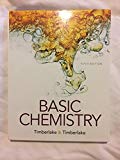
(a)
Interpretation:
The reactant which is oxidized and the reactant which is reduced should be identified.
Concept Introduction:
The
Oxidation is the process in which either there is loss of electrons, oxidation number increases, or loss of hydrogen atoms takes place.
Reduction is the process in which either there is gain of electrons, oxidation number decreases, or gain of hydrogen atoms takes place.
(a)
Answer to Problem 15.41FU
Hydrogen is getting oxidized while oxygen is getting reduced in the chemical reaction.
Explanation of Solution
Given information:
The reaction between hydrogen gas and oxygen gas results in the formation of aqueous hydrogen peroxide.
The chemical reaction is given as:
Here, in the above reaction, the oxidation state of hydrogen is 0 on left hand side as it is present in elemental state. Similarly, oxidation state of oxygen is 0 on left hand side.
Now, calculate the oxidation state of oxygen in
First, oxidation state of hydrogen is assigned as +1. Let x be the oxidation state of oxygen and the compound is neutral. Thus,
Now, oxidation state of hydrogen increases from 0 to +1, thus, it is oxidized whereas oxidation state of oxygen is decreases from 0 to -1, thus it is reduced.
(b)
Interpretation:
The oxidizing agent in the given chemical reaction should be determined.
Concept Introduction:
The oxidizing agent can be defined as the substance that has ability to extract the electrons from the other substance in the redox reaction.
(b)
Answer to Problem 15.41FU
Oxygen is an oxidizing agent in the chemical reaction, since it is getting reduced.
Explanation of Solution
Given information:
The reaction between hydrogen gas and oxygen gas results in the formation of aqueous hydrogen peroxide.
The chemical reaction is given as:
Here, in the above reaction, the oxidation state of hydrogen is 0 on left hand side as it is present in elemental state. Similarly, oxidation state of oxygen is 0 on left hand side.
Now, calculate the oxidation state of oxygen in
First, oxidation state of hydrogen is assigned as +1. Let x be the oxidation state of oxygen and the compound is neutral. Thus,
Now, oxidation state of hydrogen increases from 0 to +1, thus, it is oxidized whereas oxidation state of oxygen is decreases from 0 to -1 by addition of electron, thus it is reduced.
Therefore, oxygen is an oxidizing agent as it is reduced.
(c)
Interpretation:
The reducing agent in the given chemical reaction should be determined.
Concept Introduction:
The reducing agent can be defined as the substances that have ability to donate the electrons to the other substance in the redox reaction.
(c)
Answer to Problem 15.41FU
Hydrogen is reducing agent in the chemical reaction, since it is getting oxidized.
Explanation of Solution
Given information:
The reaction between hydrogen gas and oxygen gas results in the formation of aqueous hydrogen peroxide.
The chemical reaction is given as:
Here, in the above reaction, the oxidation state of hydrogen is 0 on left hand side as it is present in elemental state. Similarly, oxidation state of oxygen is 0 on left hand side.
Now, calculate the oxidation state of oxygen in
First, oxidation state of hydrogen is assigned as +1. Let x be the oxidation state of oxygen and the compound is neutral. Thus,
Now, oxidation state of hydrogen increases from 0 to +1 by loss of electron, thus, it is oxidized whereas oxidation state of oxygen is decreases from 0 to -1, thus it is reduced.
Therefore, hydrogen is a reducing agent as it is oxidized.
(d)
Interpretation:
The balanced chemical equation for the given chemical reaction should be written.
Concept Introduction:
A balanced reaction is a reaction in which number of atoms and charges should be equal on both reactant as well as on product sides.
(d)
Answer to Problem 15.41FU
The balanced chemical equation is:
Explanation of Solution
Given information:
The reaction between hydrogen gas and oxygen gas results in the formation of aqueous hydrogen peroxide.
The chemical reaction is given as:
As this reaction doesn’t takes place by direct combination of hydrogen or oxygen, catalyst is used for occurrence of this reaction.
Here, number of hydrogen atoms is two on product side as well as on reactant side and number of oxygen atoms is two on product side as well as on reactant side.
Thus, reaction is balanced.
Want to see more full solutions like this?
Chapter 15 Solutions
Basic Chemistry - Fifth Edition
 ChemistryChemistryISBN:9781305957404Author:Steven S. Zumdahl, Susan A. Zumdahl, Donald J. DeCostePublisher:Cengage Learning
ChemistryChemistryISBN:9781305957404Author:Steven S. Zumdahl, Susan A. Zumdahl, Donald J. DeCostePublisher:Cengage Learning ChemistryChemistryISBN:9781259911156Author:Raymond Chang Dr., Jason Overby ProfessorPublisher:McGraw-Hill Education
ChemistryChemistryISBN:9781259911156Author:Raymond Chang Dr., Jason Overby ProfessorPublisher:McGraw-Hill Education Principles of Instrumental AnalysisChemistryISBN:9781305577213Author:Douglas A. Skoog, F. James Holler, Stanley R. CrouchPublisher:Cengage Learning
Principles of Instrumental AnalysisChemistryISBN:9781305577213Author:Douglas A. Skoog, F. James Holler, Stanley R. CrouchPublisher:Cengage Learning Organic ChemistryChemistryISBN:9780078021558Author:Janice Gorzynski Smith Dr.Publisher:McGraw-Hill Education
Organic ChemistryChemistryISBN:9780078021558Author:Janice Gorzynski Smith Dr.Publisher:McGraw-Hill Education Chemistry: Principles and ReactionsChemistryISBN:9781305079373Author:William L. Masterton, Cecile N. HurleyPublisher:Cengage Learning
Chemistry: Principles and ReactionsChemistryISBN:9781305079373Author:William L. Masterton, Cecile N. HurleyPublisher:Cengage Learning Elementary Principles of Chemical Processes, Bind...ChemistryISBN:9781118431221Author:Richard M. Felder, Ronald W. Rousseau, Lisa G. BullardPublisher:WILEY
Elementary Principles of Chemical Processes, Bind...ChemistryISBN:9781118431221Author:Richard M. Felder, Ronald W. Rousseau, Lisa G. BullardPublisher:WILEY





